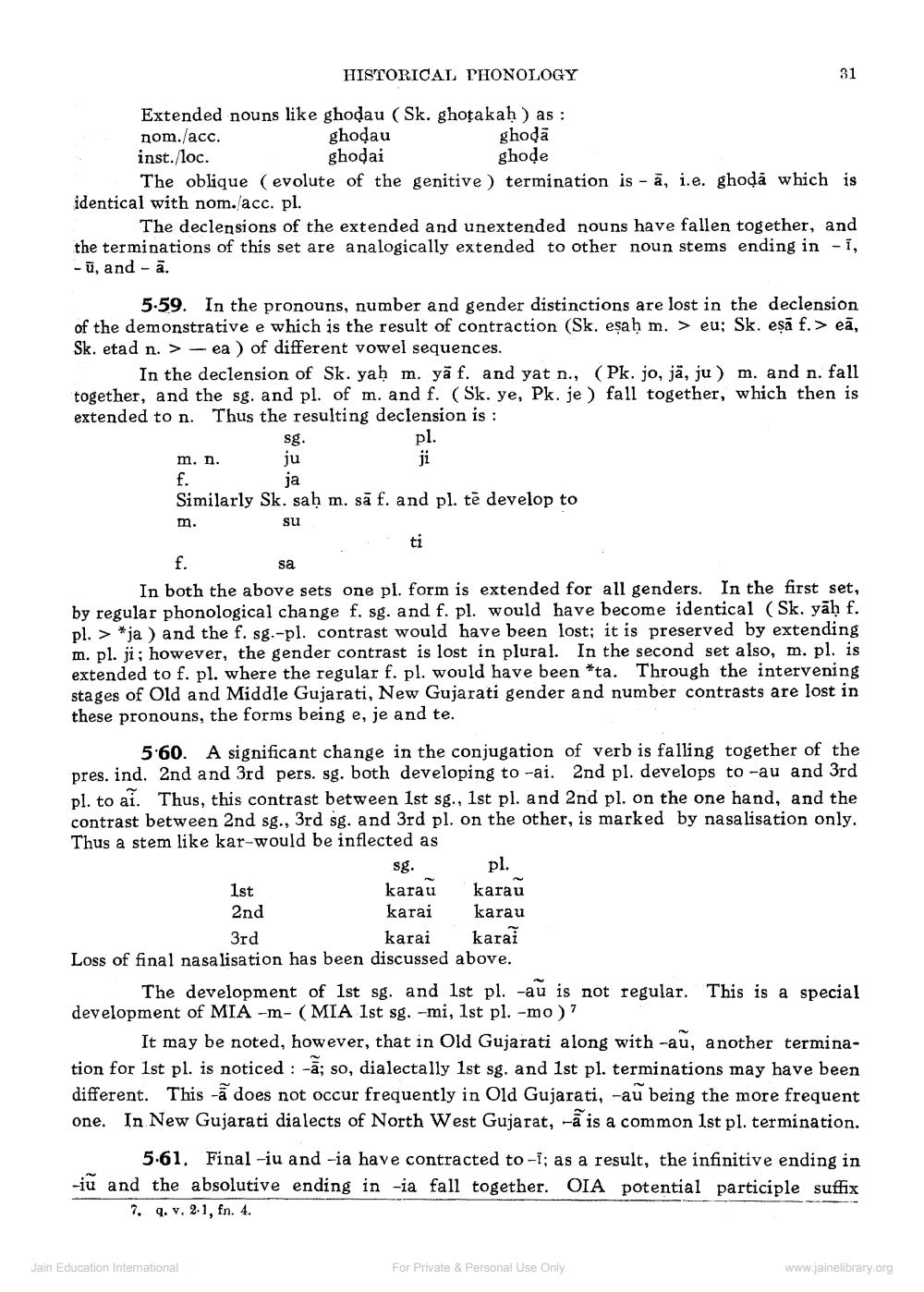________________
HISTORICAL PHONOLOGY
Extended nouns like ghodau (Sk. ghoțakah ) as : nom.acc.
ghodau
ghoda inst.loc.
ghodai
ghode The oblique (evolute of the genitive ) termination is - ā, i.e. ghoda which is identical with nom. acc. pl.
The declensions of the extended and unextended nouns have fallen together, and the terminations of this set are analogically extended to other noun stems ending in -i, - ū, anda.
5.59. In the pronouns, number and gender distinctions are lost in the declension of the demonstrative e which is the result of contraction (Sk, eşa h m. > eu; Sk. esa f.> eā, Sk. etad n. > - ea ) of different vowel sequences.
In the declension of Sk. yah m. yā f. and yat n., (Pk. jo, ja, ju ) m. and n. fall together, and the sg. and pl. of m. and f. (Sk. ye, Pk. je ) fall together, which then is extended to n. Thus the resulting declension is :
pl. m. n.
sg.
ja
Similarly Sk. saḥ m. să f. and pl. të develop to
su
sa
In both the above sets one pl. form is extended for all genders. In the first set, by regular phonological change f. sg. and f. pl. would have become identical (Sk. yah f. pl. > *ja ) and the f. sg.-pl. contrast would have been lost; it is preserved by extending m. pl. ji; however, the gender contrast is lost in plural. In the second set also, m, pl. is extended to f. pl. where the regular f. pl. would have been *ta. Through the intervening stages of Old and Middle Gujarati, New Gujarati gender and number contrasts are lost in these pronouns, the forms being e, je and te.
ti, New Gujarat have been *ta. tbcond set also, m.pling
5-60. A significant change in the conjugation of verb is falling together of the pres. ind. 2nd and 3rd pers. sg. both developing to -ai. 2nd pl. develops to -au and 3rd pl. to ai. Thus, this contrast between Ist sg., 1st pl. and 2nd pl. on the one hand, and the contrast between 2nd sg., 3rd sg. and 3rd pl. on the other, is marked by nasalisation only. Thus a stem like kar-would be inflected as
sg. pl 1st
karau karau 2nd
karai karau
karai karai Loss of final nasalisation has been discussed above.
3rd
The development of 1st sg. and 1st pl. -au is not regular. This is a special development of MIA -m- (MIA 1st sg. -mi, 1st pl. -mo)?
It may be noted, however, that in Old Gujarati along with -au, another termination for 1st pl. is noticed : -ā; so, dialectally 1st sg. and 1st pl. terminations may have been different. This - does not occur frequently in Old Gujarati, -au being the more frequent one. In New Gujarati dialects of North West Gujarat, -ā is a common 1st pl. termination.
5.61. Final -iu and -ia have contracted to -1; as a result, the infinitive ending in -iu and the absolutive ending in -ia fall together. OIA potential participle suffix
7. q. v. 2.1, fn. 4.
Jain Education International
For Private & Personal Use Only
www.jainelibrary.org




